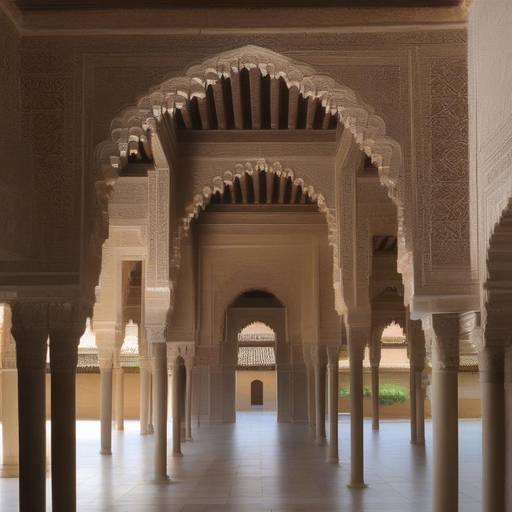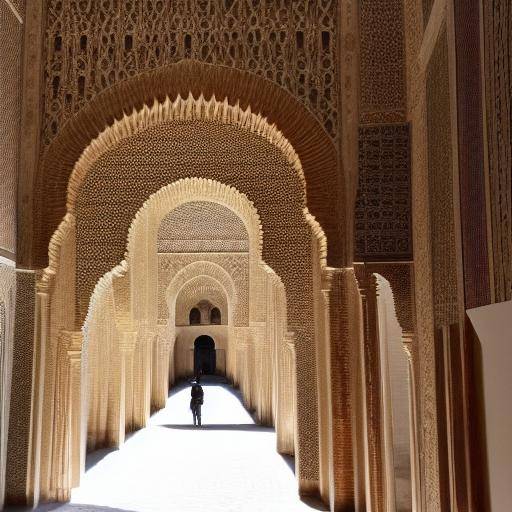
The Alhambra of Granada is an architectural treasure that has captivated visitors from around the world for centuries. Its exquisite Moorish architecture, rich history and stunning beauty make it a must-see tourist destination. In this article, we will explore in detail the essence of the Alhambra, the city of Granada and the Moorish architecture, revealing its secrets and charms. From its historical meaning to future trends, this complete guide will take you on a journey through this wonder of the world. Get ready to discover the magic of the Alhambra in Granada!
Introduction
The Alhambra: Treasure of Granada
The Alhambra is much more than a palace. It is a living testimony of the history, culture and Moorish art that has endured over the centuries. Located in the majestic hills of Granada, this palatial complex is an architectural gem that dazzles those who have the privilege of visiting it. In this introductory section, we will enter into the charm and relevance of the Alhambra, with a look at what awaits us in this fascinating journey.
The Alhambra of Granada has witnessed the coexistence of different cultures throughout the centuries, which is reflected in its architecture, gardens and works of art. This article will take you to a journey through time, revealing the best kept secrets of this world heritage.
History and Background
Origins of the Alhambra
The Alhambra has its roots in the history of Granada and the legacy of Muslim culture on the Iberian peninsula. Its origins date back to the ninth century, when the Muslims established the emirate of Cordoba. Over time, the construction of the Alhambra became a symbol of power and wealth, and today it remains a living witness of the golden era of Islam in the region.
The Alhambra survived the fall of Granada in 1492 and, over the centuries, has witnessed the influence of various cultures, including the Christian and the Renaissance. This crucible of influences has left an indelible mark on the architecture and art of the Alhambra, making it a multifaceted legacy that transcends borders and eras.
Evolution throughout the century
Throughout the centuries, the Alhambra has experienced significant transformations that have contributed to its current character and splendor. From its function as a military fortress in the early days until its subsequent conversion into a royal palace, the Alhambra has witnessed an architectural and cultural evolution that has enriched it with layers of history and meaning.
In the nineteenth century, the Alhambra experienced an artistic and cultural rebirth, as travelers, poets and artists from around the world were captivated by its beauty. This resurgence contributed to its recognition as one of the most emblematic monuments of the Moorish architecture, consolidating its place in the collective history and imagination.
Analysis in Deep
The Alhambra is much more than a set of buildings and gardens; it is a microcosm of art, poetry and history. Each corner of this palatial complex contains deep meanings and symbolisms that reflect the vision of the world of its creators. In this section, we will enter the most fascinating details of the Alhambra, unraveling its secrets and revealing its impact on the art and culture of the region.
Its intricate geometric patterns, exquisite decorative details and elaborate sources are testimony to the artisanal mastery and spiritual wealth that permeated life in the Alhambra. In addition, we will explore the architectural innovations and artistic contributions that make it an inescapable reference of the Moorish architecture.
Comparative analysis
The Alhambra vs. Granada: Andalusian Charm
Both the Alhambra and the city of Granada are witness to a splendour past that is still ongoing. In this section, we will compare the influence of the Moorish architecture in both contexts, highlighting similarities and differences that will reveal the cultural wealth of the region. From the zocos of Granada to the palaces of the Alhambra, each corner transports us to a time of splendor and spirituality.
Granada, with its labyrinth of narrow streets, flowery patios and the majestic Alhambra as a backdrop, awakens the imagination and evokes a unique atmosphere that merges the traditional with the contemporary. The Arab influence is perceived in architecture, gastronomy and music, giving the city a vibrant and welcoming identity.
Impact of Morisca Architecture
The Moorish architecture, with its impressive fusion of geometric elements, intricate patterns and the magistral use of water as a central element, has left a lasting legacy in the Alhambra and Granada. In this section, we will analyze the impact of this architecture on the daily life, spirituality and art of the region, revealing its influence on identity and cultural landscape.
The symbiosis between the Moorish architecture and life in the Alhambra and Granada is an example of aesthetic and functional harmony that transcends temporal and cultural boundaries. From the inner courtyards of the Alhambra to the Arab baths of Granada, the Moorish architecture has permeated every corner of sensory and emotional experiences, creating an aesthetic universe that transcends time.
Practical Tips and Recommendations
Unique Experiences in the Alhambra
Are you planning to visit the Alhambra? So, this section will give you valuable advice and recommendations to make the most of your experience. From booking tickets to the selection of the best routes to explore the Alhambra, here you will find everything you need to know to plan your visit optimally.
We will also offer you suggestions to discover the hidden charms of the Alhambra, such as the Torre de la Vela, the gardens of the Generalife and the viewpoints that offer stunning views of Granada. In addition, we will give you practical advice on the best time of the year to visit the Alhambra and how to avoid agglomerations, so that you can fully enjoy this unique experience.
Conclusions and FAQs
Conclusions
In conclusion, the Alhambra of Granada is an incomparable treasure that encapsulates the magic and history of the Moorish architecture. Its intricate designs, lush gardens and cultural legacy make it an indispensable destination for those seeking to explore the historical and artistic wealth of the region.
Frequently asked questions
What is the best time to visit the Alhambra?
Spring and autumn are usually the ideal seasons to visit the Alhambra, as the weather is more temperate and the gardens are in full bloom.
Is it necessary to book in advance to visit the Alhambra?
Yes, it is highly recommended to book tickets in advance, especially during the high season, to ensure your access to this emblematic place.
What architectural elements are more representative of the Moorish architecture in the Alhambra?
The most representative architectural elements of the Moorish architecture in the Alhambra include horseshoe arches, plaster lattices, stucco details and patios with fountains and gardens, which create a serene and evocative atmosphere.
Does the Alhambra offer guided tours in various languages?
Yes, the Alhambra offers guided tours in several languages, allowing you to explore more deeply its rich history and architecture.
What is the historical importance of the Alhambra?
The Alhambra has been a symbol of coexistence between different cultures over the centuries, as well as being a testimony of the splendor of Moorish art on the Iberian peninsula.
What works of art stand out in the Alhambra?
Among the most outstanding works of art of the Alhambra are the intricate details of wooden ceilings, decorative tiles and plaster reliefs that adorn their rooms and patios.
Is the Alhambra accessible to people with reduced mobility?
The Alhambra has facilities adapted for people with reduced mobility, including ramps and access to areas such as the Palacio de Carlos V and the Jardines del Generalife.
Summary
The Alhambra of Granada is a treasure that awakens the imagination and leaves a lasting impression on all those who have the privilege to know it. Its Moorish architecture, its fascinating history and its influence in the city of Granada make it a unique destination in the world. From the stunning views to the most intricate details, the Alhambra continues to surprise and captivate visitors from all over, inviting us to immerse ourselves in the beauty of a past era that continues to resonate in the present.
Discovering the secrets of the Alhambra is to get into a world of art, history and culture that transcends time, leaving an imbberable mark on those who have the fortune to explore it. With its Moorish architecture that celebrates beauty, symmetry and spirituality, the Alhambra invites us to contemplate the greatness of the past and to appreciate its legacy in the present.

